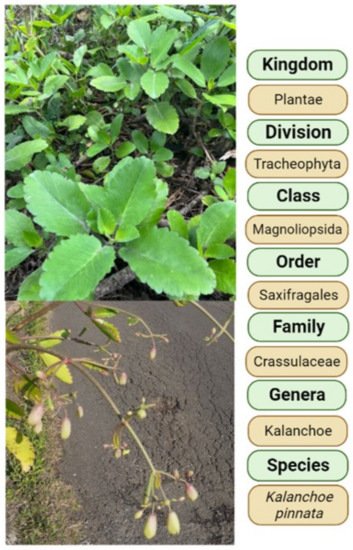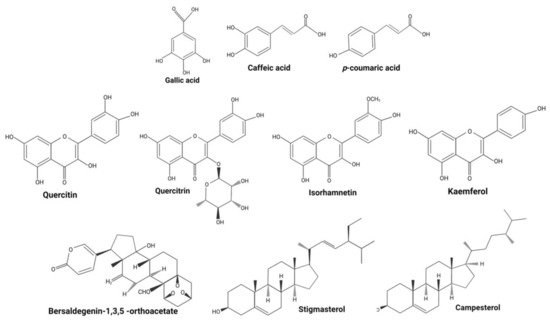You're using an outdated browser. Please upgrade to a modern browser for the best experience.
Please note this is an old version of this entry, which may differ significantly from the current revision.
Subjects:
Biochemistry & Molecular Biology
Kalanchoe pinnata (Lam) Pers. (syn. Bryophyllum pinnatum Lam.), belonging to the genus Kalanchoe, is a succulent plant cultivated in gardens, which can be found as a herb or shrub. The bioactive ingredients in Kalanchoe pinnata, a succulent herb with ethnomedical applications for several diseases, including cancer, and reveal its anticancer mechanisms through a molecular approach.
- Kalanchoe pinnata
- phytochemicals
- antitumor activity
1. Introduction
Cancer is a genetic disease that displays a variety of molecular alterations in the genome of somatic cells [1]. Cancer cells’ traits, such as sustained proliferation, resistance to cell death, angiogenesis capacity, invasion, evasion of immune surveillance, and metastasis, could be the targets of bioactive compounds of medicinal plants. These alterations include small or large structural variations due to epigenetic changes characterized by the addition or removal of chemical groups from/to DNA, histones [2], or RNA [3]. As such, inherited or sporadic mutations cannot only activate oncogenes or deactivate tumor suppressor genes, but may even lead to reversible chemical modifications such as the methylation of DNA, histones, or RNA, which can affect gene expression without changing DNA sequences. Plants from the genus Kalanchoe (Fam: Crassulaceae) have a global distribution in warm climates, where they are used as ornamental plants. Some of the 200 Kalanchoe species are known for their curative uses in different diseases, including cancer. Natural remedies are used on a large scale worldwide, and herbal extracts are obtained from a great variety of plants. At the level of chemical composition, Kalanchoe species include flavonoids, bufadienolides, fatty acids, triterpenoids, alkaloids, phenolic acids, saponins, tannins, glycosides, and kalanchosides [4,5,6]; many of these constituents have remarkable anticancer potential. Numerous studies have evaluated the anticarcinogenic efficacy of these natural bioactive molecules. For example, quercetin has been reported to inhibit the proliferation of human breast cancer cells [7]. Bufadienolides have been shown to have antiangiogenic activity, cause inhibition of cell growth and proliferation, and induce cell death [8]. Antiproliferative activity has also been reported for triterpenes [9] and kalanchosides [5]. Important issues in cancer treatment are drug-related cumulative toxicity and chemoresistance. Hence, combination therapy offers good results due to the use of different targets and reduced adverse effects. Alternative therapy options may include the use of phytochemicals.
The features of Kalanchoe pinnata (Figure 1) and its phytochemicals, with a focus on the mechanisms underlying its chemopreventive and therapeutic properties.

Figure 1. Taxonomic classification of K. pinnata. Source: Photos by authors, image created with BioRender.com.
2. Phytochemical Constituents of Kalanchoe pinnata
Kalanchoe pinnata (Lam) Pers. (syn. Bryophyllum pinnatum Lam.), belonging to the genus Kalanchoe, is a succulent plant cultivated in gardens [11], which can be found as a herb or shrub. The plant has opposite, simple, and compound leaves, with a red to dark purple crenate margin. It reproduces from seeds and vegetatively through leaves [12], presenting clusters of reddish-purple pendulous flowers [13]. K. pinnata is used in traditional medicine to treat different diseases including cancer [6]. Mora-Pérez and Hernández-Medel [14] analyzed the ingredients of K. pinnata and found alkaloids and sterols in methanolic root extract, and terpenes, sterols, flavonoids, chlorides, nitrates, and potassium in methanolic stem extract. The leaves of this plant contain phenols (gallic acid), flavonoids (quercetin) (in methanol extract), lycopenes, and β-carotenes (in petroleum ether) [15], as well as tannins and alkaloids [16]. Jaiswal et al. [17] found that the phenolic content of leaves was 28.4 ± 2 µg mg−1 and suggested that this was responsible for their antioxidant capacity. El Abdellaoui et al. [18] detected three phenolic acids (gallic, caffeic, and coumaric acids), three flavanol glycosides (quercetin, isorhamnetin, and kaempferol), 4′,5-dihydroxy-3′,8-dimethoxyflavone 7-O-β-D-glucopyranoside, and quercitrin [19]. Bufadienolides such as bersaldegenin acetate-2, -3, -4, -5, bryophyllin a, bryophyllin c, and bersaldegenin-1,3,5-orthoacetate [20] have also been found. Reported phenanthrene derivatives include Ψ-taraxasterol and 18-α-oleanane, and other ingredients include sterols; bryophynol, bryophyllol, and bryophollone [21]; stigmasterol [22]; campesterol, 24-epiclerosterol, (24R)-5α-stigmasta-7,25-dien-3β-ol, 5 α-stigmast-24-en-3β-ol, and 25-methyl-5α-ergost-24(28)-en-3β-ol [23] (Figure 2). The leaves of K. pinnata are rich in ascorbic acid (vitamin C) and contain riboflavin, thiamine, niacin, magnesium, calcium, potassium, phosphorus, sodium, and microelements such as iron and zinc [16]. K. pinnata flowers contain a higher concentration of glycosides [24], similar to other Kalanchoe species.

Figure 2. Structures of major phytochemicals reported in K. pinnata. Source: Image created with BioRender.com.
3. Activity of Kalanchoe pinnata in Cancer
Several plant components have been identified as sources of anticancer therapeutics. However, those components should be investigated in clinical trials to confirm their pharmacokinetic effects. Members of the Kalanchoe genus (Crassulaceae) have remedial properties for a wide range of diseases such as gastric ulcers, urolithiasis, bacterial, viral, and parasitic infections, skin diseases, cold, memory improvement, or even improvement in sleep quality when undergoing cancer treatment. Based on ethnobotanical evidence, the Kalanchoe genus has been evaluated on various cancer cell lines (Table 1). The phytochemicals present in K. pinnata have been analyzed in a variety of studies on cancer.
Table 1. Anticancer properties found in the Kalanchoe genus.
| Kalanchoe | Subject | Effect | Study Type | Cell Line | Reference |
|---|---|---|---|---|---|
| K. daigremontiana Raym.-Hamet and H. Perrier | Ovarian, cervical, breast cancer, and melanoma | Antiproliferative, cytotoxic, and antioxidant activity. Cell cycle arrest and caspase-independent cell death |
In vitro | SCOV-3, HaCaT, HeLa, MCF-7, A375 | [8,20,26,27,28] |
| K. integra var. crenata (Andr.) | Cardiotoxicity by doxorubicin Colorectal adenocarcinoma, lung cancer, mesothelioma, hepatocarcinoma, breast cancer |
Cardio-protection against cardiotoxicity by cancer therapy Apoptosis |
In vivo (rats) In vitro |
DLD-1, A549, SPC212, HepG2, MCF-7 |
[9,29] |
| K. tubiflora (Harvey) | Lung cancer Lung adenocarcinoma, oral adenosquamous carcinoma, melanoma, and leukemia cell lines |
Induction of autophagy Cell cycle arrest and senescence Cell cycle arrest and apoptosis Cytoprotective autophagy |
In vitro In vitro, in vivo (mice) |
CL1-5 A549, Cal-27, A2058, HL-60 |
[30,31,32] |
| K. gastonis-bonnieri Raym.-Hamet | Benign prostatic hyperplasia Prostate cancer |
Antiproliferative activity and apoptosis induction Antiproliferative activity, apoptosis induction, and androgen receptor degradation |
In vitro | Stromal cells LAPC-4, LNCaP, PC-3, DU145 |
[33,34] |
| K. flammea | Prostate cancer | Apoptosis induction and cell cycle arrest | In vitro | PC-3, LNCaP, PrEC | [35] |
| K. laetivirens | Lung cancer | Reversion of etoposide resistance | In vitro | A549, A549RT-eto | [36] |
| K. gracilis (L.) DC | Murine macrophage and human hepatocarcinoma | Antiproliferative, antioxidant, and anti-inflammatory activity | In vitro | RAW264.7, HepG2 | [37] |
| K. beharensis | Acute myeloid leukemia | Apoptosis induction, inhibition of NF-κB | In vitro | HL-60, HL60R | [38] |
| K. brasiliensis | Kidney carcinoma | Cytotoxic activity | In vitro | 3T3, 786-0 | [39] |
| K. laciniata | Baby hamster kidney cell line | Cytotoxic activity | In vitro in vivo (mice) | BHK-21 | [40] |
Plant extracts by themselves do not produce a significant effect against cancer, but they may enhance therapeutic efficacy when combined with chemotherapeutic drugs. The most studied natural compounds are polyphenols, which are widely distributed in plant tissues. These compounds are secondary metabolites produced for protection against bacteria, fungi, and insects. Natural phenols more studied for their properties are curcumin, epigallocatechin-3-gallate, resveratrol, quercetin, and myricetin [25], of these compounds, quercetin is found in K. pinnata.
This entry is adapted from the peer-reviewed paper 10.3390/molecules27196425
This entry is offline, you can click here to edit this entry!
